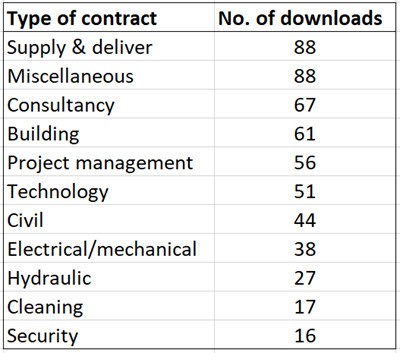
Winning Northern Territory Government tenders is not as easy as it used to be. For starters, continual revision of procurement guidelines has raised the bar in term of the standards that contractors are expected to comply with. Added into the mix is the fact that there is less work around so more businesses are competing for it. In my view too many good, capable businesses do not do themselves justice in the tender process and as a result they are not winning their fair share of contracts. If you’re one of these businesses, this article might help you.
Yesterday I had a quick look at NT Quotations and Tenders Online and randomly selected one tender from each category to see how many businesses had expressed an interest. This is what I found:

These numbers are scary because, while not every download will result in a response, it is clear that competition really is intense. Being technically better than your competitors won’t get you across the line by itself. This is because the evaluation process is broadly designed to determine how good you are in three different areas: Your technical expertise (past performance, timeliness and capacity, Your compliance with specified non-technical requirements (local content, innovation, scope specific criteria), and
Your price competitiveness
This article is about a fourth criteria that is not specifically mentioned in the tender documents and with which many businesses struggle: How well you respond to the evaluation criteria. Here are some principles that could help you with your response to any tender:
To Bid or not to bid? Responding to a tender can take a lot of time so don’t waste effort on a tender you’re unlikely to win. To get a provisional assessment of your chances you should kick off with a simple bid or no bid evaluation. There are lots of ways of doing this and I just had 15million hits by googling “to bid or not to bid”. The fact that that there are so many internet articles on this topic suggests that lots of people can see benefits in using such a tool. Find a way that works for you or if all else fails, score yourself out of ten on each evaluation criteria then guess the scores for some of your major competitors. If you’re not in the same ballpark, don’t bid.
Play by the rules. Evaluators have to play by the rules and you must too. They can only evaluate your response based on the answers you give. You can’t assume that an evaluator will give you credit for something s/he knows about you but which you haven’t mentioned in your response form. Don’t leave any blanks and make sure you answer all questions even if you think they are irrelevant or that that you have already answered them in a previous section.
This is not an English test. A well written response may score you an extra point because it is easy to understand but if it doesn’t contain good content it will get you nowhere. Good content starts with good honest facts. If you’re uncomfortable with writing use bullet points.
Use subheadings and bullet points. Using subheadings can help you emphasise important things and will help to ensure you don’t overlook something. For example, if a criteria states “Provide details of the design team, project team and construction team” use three subheadings to respond. Similarly, if the criteria uses bullet points, use the same bullet points in your response and don’t leave any out.
Think of the government’s needs as well as your own capabilities. The government is looking for good customer service although the response forms won’t explicitly state this. Ultimately they are looking for a contractor who will do what they said they will do on time and to specification with no re-work. These contractors will also be easy to deal with and will be responsive to requests for information or variations etc. Put yourself in the government’s shoes and think about the unstated things that they want. Try and work these into your response.
State the benefits of your service/ approach. For example, if you’re going to use the latest equipment that saves time, makes less noise and uses less power or fuel state this and the associated benefits eg, “Using this machine will ensure we meet the tight deadline for completion while minimising excessive noise which will reduce risk of operator hearing loss while minimising disturbance to the local community. It will also help the government achieve its goal of minimising its carbon footprint”. OK that's a mouthfull but you know what I mean.
Don’t just state the facts, demonstrate them. For example, when you’re asked to provide examples of similar experience, don’t just list these jobs, tell a story about them. You could mention an unusual or unexpected problem that you overcame, e.g. how you successfully dealt with excessively wet ground conditions or a particularly confined space and were still able to deliver on time and to budget.
Use brief resumes and statements of capabilities. If you’re asked to identify key personnel who will be working on the contract don’t just list their names and position in your organisation. Say something about them to demonstrate their experience, e.g. years of experience, qualifications, and specific examples of doing similar work. Similarly, consider doing this for subcontractors. Say why you are using a particular subcontractor and consider attaching their own statement of capability to demonstrate that you’re working with a competent person/business.
Get serious about risk management and safety. Many tenderers have difficulty with responses dealing with risk management and WHS. The main reason for this is that their own systems are not particularly well developed. These areas are increasingly being audited as part of the government’s contract performance management criteria. If you cannot demonstrate good risk and safety systems you will be at a disadvantage during evaluation. You may also be contravening the law so it is in your interest to improve them.
Face up to local development. This can be another challenging area, particularly criteria relating to indigenous employment and community involvement. These have been core policy areas of successive Territory governments so if you can demonstrate persistent commitment in this area you will be helping the government achieve its goals. I have worked with one client for a number of years who has tried really hard to develop this aspect of their business. They have done well and it has definitely contributed to their competitive advantage when tendering for government work.
Learn from your losses. A debrief for a failed tender is a painful experience but if you handle it well it can be invaluable. Explain that you are not contesting the award and need the feedback to improve your own business. Ask lots of questions and listen carefully to the answers. Resist the temptation to defend yourself. Handled properly a debrief can help you win your next bid and it may even identify weakness in your own business.
If some of this seems too hard, confusing or time-consuming get someone to help you compile your next tender. You may only need to do this once because the evaluation criteria across most NTG tenders are similar. You will be able to refine and re-use the content for future tenders and if you do this properly your investment in time for each successive tender will decrease while the probability of success should increase.
If you own a good capable business, use the tips above to make sure you do yourself, your business, your staff and your customer justice next time you submit a tender.